10 Characteristics of Oboe Staples
Posted by Ann Hodge on Mar 14th 2022
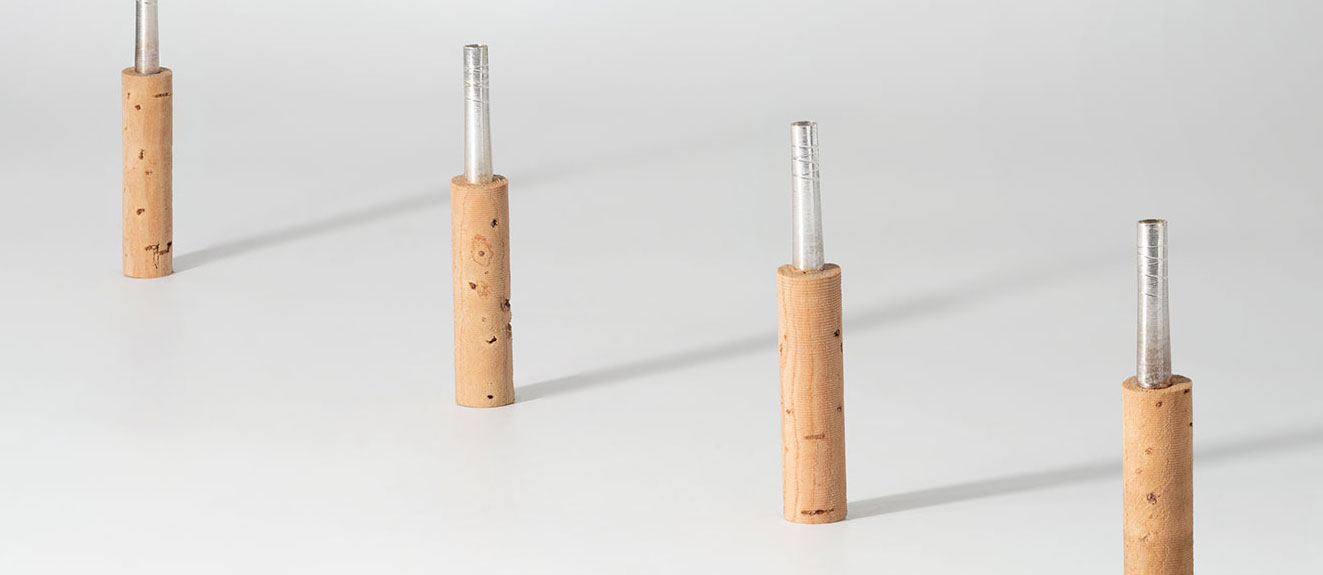
Chapters
- How to Select Your Oboe Staple
- Introduction
- Chapter 2
- 10 Characteristics of Oboe Staples
- Chapter 3
- 15 Oboe Staple Brands
- Chapter 4
- Oboe Mandrels
- Conclusion
- Oboe Staple Selection Tool
Chapter 2
10 Characteristics of Oboe Staples
Staple Characteristics
When the perfect staple dimensions work together with your oboe, cane shape, and reed making style, the result is effortless intonation that allows you to focus on your tone and musicality.
Because of the extensive collection of staples carried at Hodge Products, we were able to accurately measure and compare thousands of staples. In this study, we measured between 50 and 100 staples each from 14 brands in 36 models.
By measuring the staple tip ellipse dimensions, base diameter, length, wall thickness, taper angles, and internal volume, we were able to calculate the tip area, base area, ellipse ratio (how round or flat the staple tip opening is), and tip-to-base ratio (average taper.) These measurements influence the tone, pitch, intonation, projection, resistance, and reed throat aperture.
Let's review each aspect individually to understand how to select the perfect staple.
1. Base Area
The base area of the staple affects projection and pitch within the scale. Changes made to the base area will double the effect on pitch and intonation compared to changes made to the staple tip. Projection is affected by the air speed and air flow concentration through the staple, primarily at the base.
Small Staple Base
Sound
Pros: Sweet, warm, secure, stable, easier low notes, good projection in orchestra and solos (with the necessarily higher breath support)
Cons: Restricted flexibility and dynamic range
Pitch of the Octaves
- Slightly and increasingly raises the pitch of the lower octave as it goes up.
- The second octave flattens increasingly from E5 to a significantly flat C6.
Details about correcting the octave issues can be found in Understanding the Oboe Reed, p. 449. All in all, the negatives to a small staple base can be corrected successfully to enjoy the desired positive characteristics.
Staples with a Small Base
- Chiarugi 1
- Guercio 1 (less tapered), D10 and D11 (more tapered), D12, and R12
- Lorée DM
- Marigaux 2 (less tapered)
The Guercio D12 and R12 staples bridge the gap between the staples with very small bases and the group of staples with medium-sized bases. Since their tip size falls into the average range, they make a good choice for experimenting with a smaller staple base. The Marigaux 2 can also serve this purpose. Extremes in tapering have been noted above. Please see the chart in the Average Taper section for actual tip-to-base ratios.
Large Staple Base
Sound
Pros: Low notes fuller, generally better blend in chamber music
Cons: Low notes flatter and harder to control
Pitch of the Octaves
- Slightly and increasingly lowers the pitch of the lower octave as it goes up from D4.
- The second octave grows increasingly sharper from E5 to a significantly sharp C6.
All is not lost as this can be good in certain circumstances.
Graham Salter addresses the options for addressing these issues on p. 447 in Understanding the Oboe Reed.
Staples with a Large Base
- Bonazza Deluxe
- Chiarugi 2+, 3 (less tapered), 5 (most tapered), 7 (largest base and tip by far)
- Glotin
- Guercio AM, G1, and G26 (less tapered)
- Lorée AK
All of these also have correspondingly larger tip areas with the exception of the Chiarugi 5. (The significance of this is explained in the Tip-to-Base Ratio section.)
Base Area Chart
The following chart shows the base area of all the staples in our shop, from smallest to largest. At least 50 staples of each model were measured and then averaged. The color differences illustrate small, medium, and large with the red/orange section showing the range of the 'medium' group.
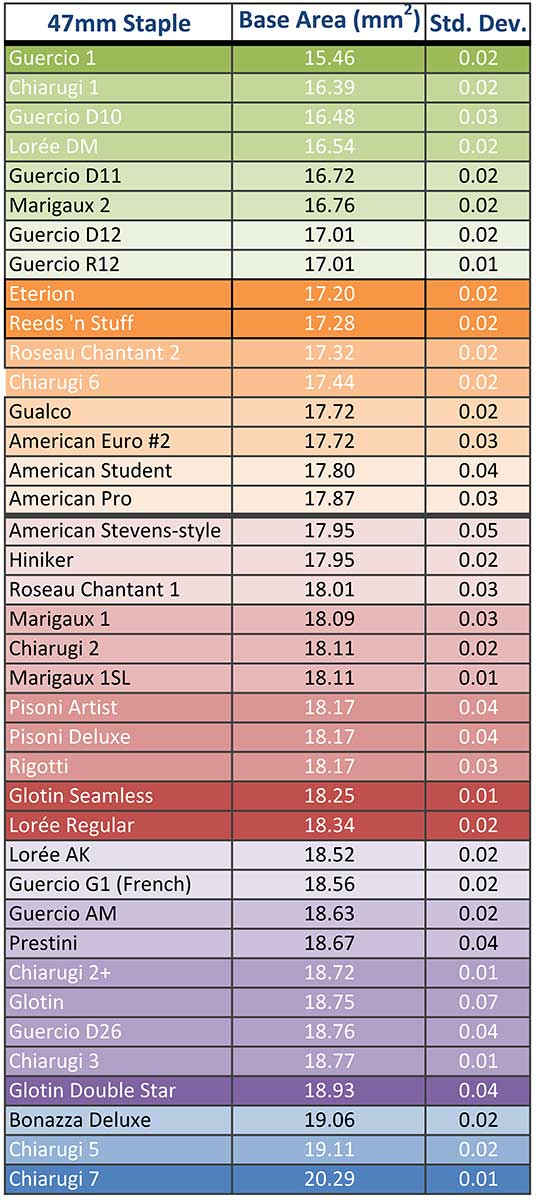
2. Tip Area
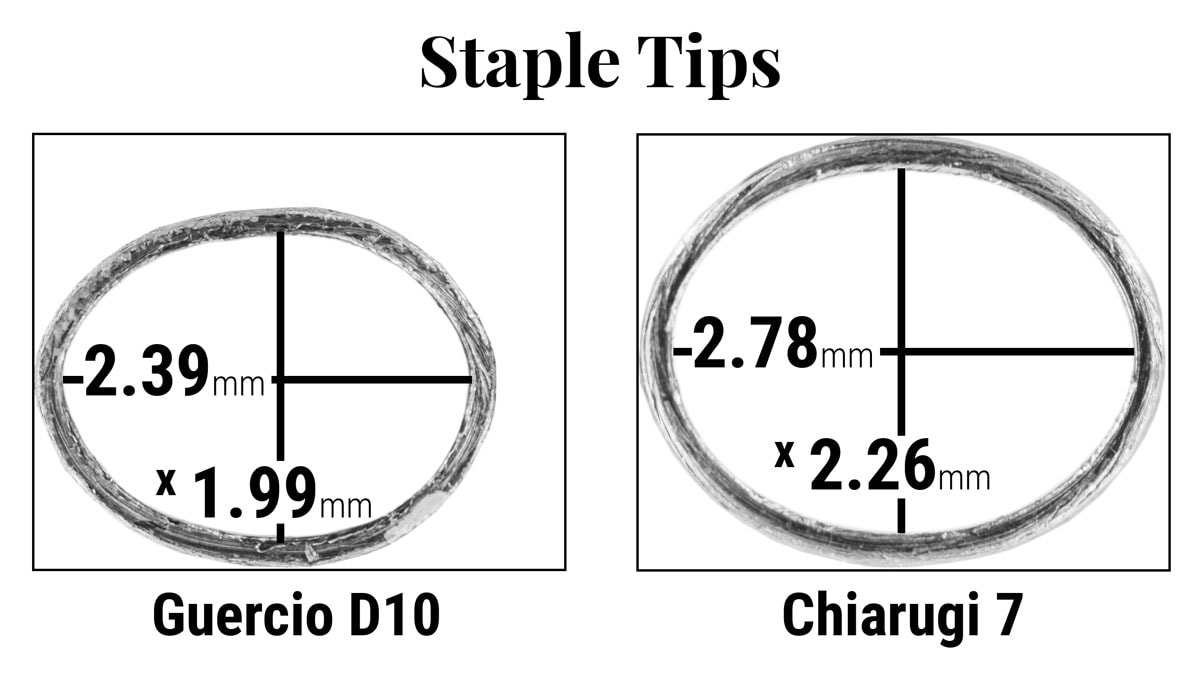
The tip area measurement is calculated from the short and long measurements taken from the staple tips. Reducing or enlarging the staple tip area has the same effect on intonation as the base diameter sizes, but at half the percentage rate.
The tip of the staple, however, has a large impact on air pressure, i.e., back pressure, so a staple with a small tip will have more back pressure than a large tip.
Small Tip Area
Reducing the staple tip is a good countermeasure to enlarging the staple base.
Sound
Pros: Lovely focus
Cons: Increased resistance
Pitch of the Octaves
- Slightly and increasingly raises the pitch of the lower octave as it goes up.
- The second octave flattens increasingly from F#5 so that it is really the most effective way to lower the top notes of the middle octave (A5-C6) that may have been raised by a large staple base.
Staples with a Small Tip Area
- Chiarugi 1
- Guercio D10, D11, and 1
- Lorée DM
Oboe Matches (suggested in Understanding the Oboe Reed)
German-style Oboes:
- Josef
- Ludwig Frank
- Mönnig
- Springer
Small-tipped staples balance out the raised second-octave design of German oboes.
Large Tip Area
An enlarged staple tip offers a countermeasure for a small staple base.
Sound
Pros: facilitates greater dynamic freedom and command, and the ability to enrich the tone of high notes, which can be safely lipped down for fullness of sound.
Cons: less refinement or sweetness, may not suit oboes with higher second octaves
Pitch of the Octaves
- Slightly and increasingly lowers the pitch of the lower octave as it goes up.
- The second octave gets increasingly sharper from E5 to C6 though less so than enlarging the base.
A larger-tipped staple can effectively raise the pitch on the upper octave that may have been compressed by a shorter staple, a long-scraped reed tip, or a wide-tipped reed.
Enlarging the tip area is often more effective at raising the region from A 5-C6 than enlarging the base, because it is less amplified and therefore easier to control around G5. (Salter p. 449)
Staples with a Large Tip Area
Medium Large
- Bonazza Deluxe
- Chiarugi 2+
- Lorée AK
- Glotin (modern)
- Guercio AM
Largest
- Chiarugi 3 and 7 (enormous – used most effectively with Dutch-style reeds)
- Guercio D26
- Roseau Chantant #2 (RC2) (Does not have an equally large base. See the discussion about this staple in the Staple Brands Section.)
Oboe Matches (for standard large-tipped staples) (suggested in Understanding the Oboe Reed)
French-style Oboes:
- Buffet
- Howarth
- Lorée Royal
- Marigaux
- Rigoutat
Large-tipped staples support the upper second octave best where French oboes have tended to be weak and comparatively flat. These staples also allow for a wider reed blade (European) or longer tip (American). (Salter p. 444)
Tip Area Chart
The following chart shows the tip area of all the staples in our shop from smallest to largest. At least 50 staples of each model were measured and then averaged. The color differences illustrate small, medium, and large with the red/orange section showing the range of the 'medium' group.
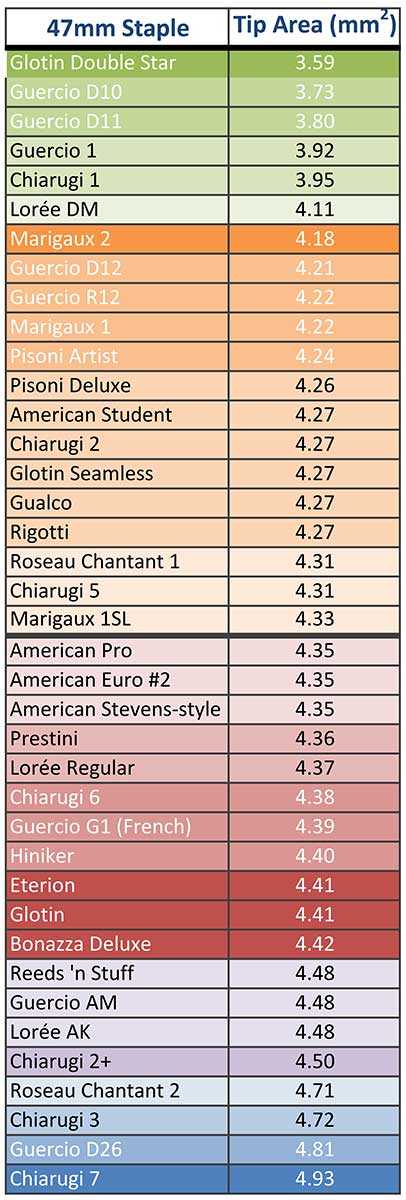
3. Tip Shape (Ellipse Ratio)
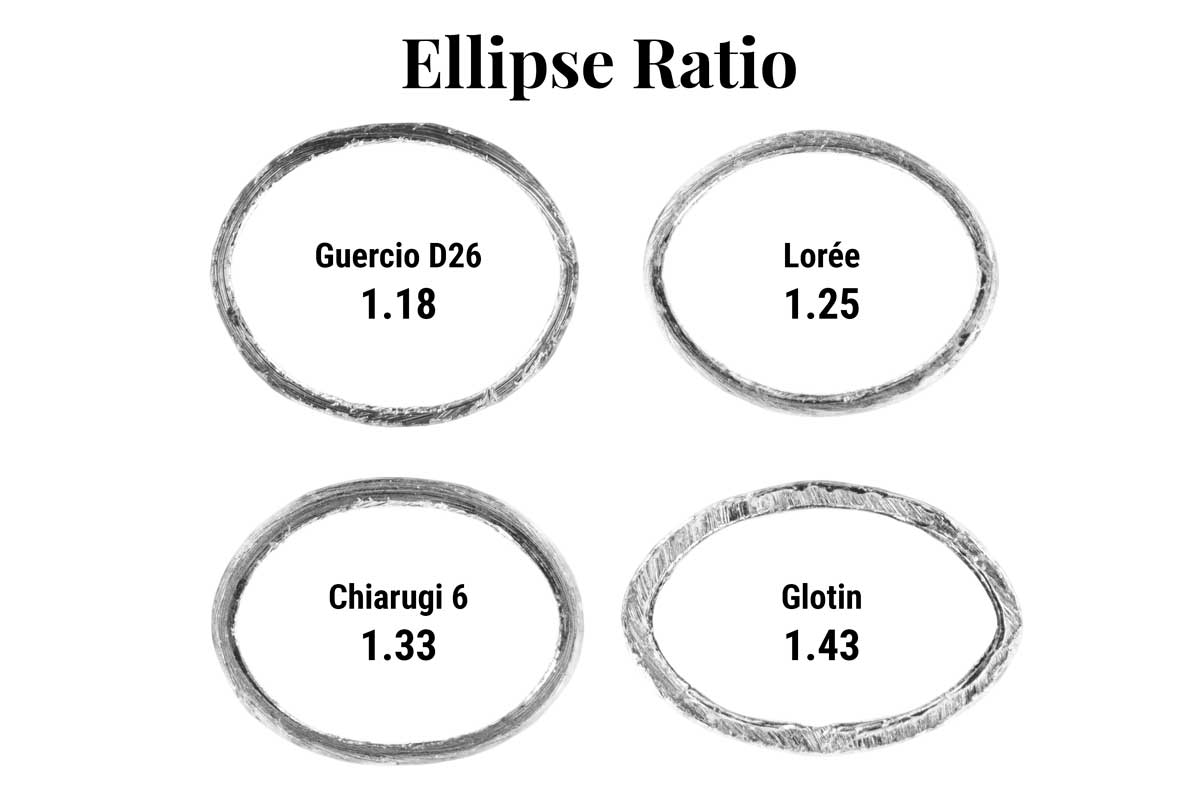
Wow! It’s amazing they can be that different. How does the ellipse ratio affect the reed?
The shape of the staple tip affects the aperture of the back of the reed near the wrap point (the throat), which, in turn, may affect the reed tip opening, though less predictably. I discussed this in the section on Reed Throat and Tip Opening in the previous chapter.
Rounder Staple Tips = more open throat
- Guercio D26, G1, D10, AM
Flatter Staple Tips = less open throat
- American Student, Euro #2
- Bonazza Deluxe
- Chiarugi 5 (Older Glotin copy)
- Glotin (modern)
- Gualco
- Pisoni Artist
Chiarugi, the staple manufacturer with the largest selection, and who manufactures staples for other brands, produces consistently well-shaped ellipses throughout.
Air Flow in Flatter Staples
Draving’s computer modeling shows that the staples with higher ellipse ratios (i.e. flatter staples) also have air exiting the staple in a more elliptical concentration. This flatter shape of airflow concentration tends to cause the notes using the F, vent keys, and 3rd octave keys to play brighter and more loudly.
Based on Table 2 in the Draving article, flatter staples reduce the back pressure, however this reduction is so slight that it will probably be unnoticeable in practice.
Tip Shape Chart
The ellipse ratio here has been calculated from the short and long measurements taken from 50 staple tips of each model and averaged. If the ellipse ratio equals '1', it is perfectly round. The higher the number, the flatter the ellipse.

Tip Size and Shape Graph
This graph combines the tip size and tip shape. The rounder staples are at the bottom of the chart and the flatter staples are at the top. The smaller-tipped staples are to the left of the chart and the larger-tipped staples are to the right. So, for example, if you’re looking for a small round staple tip, look at the staples in the bottom left corner.
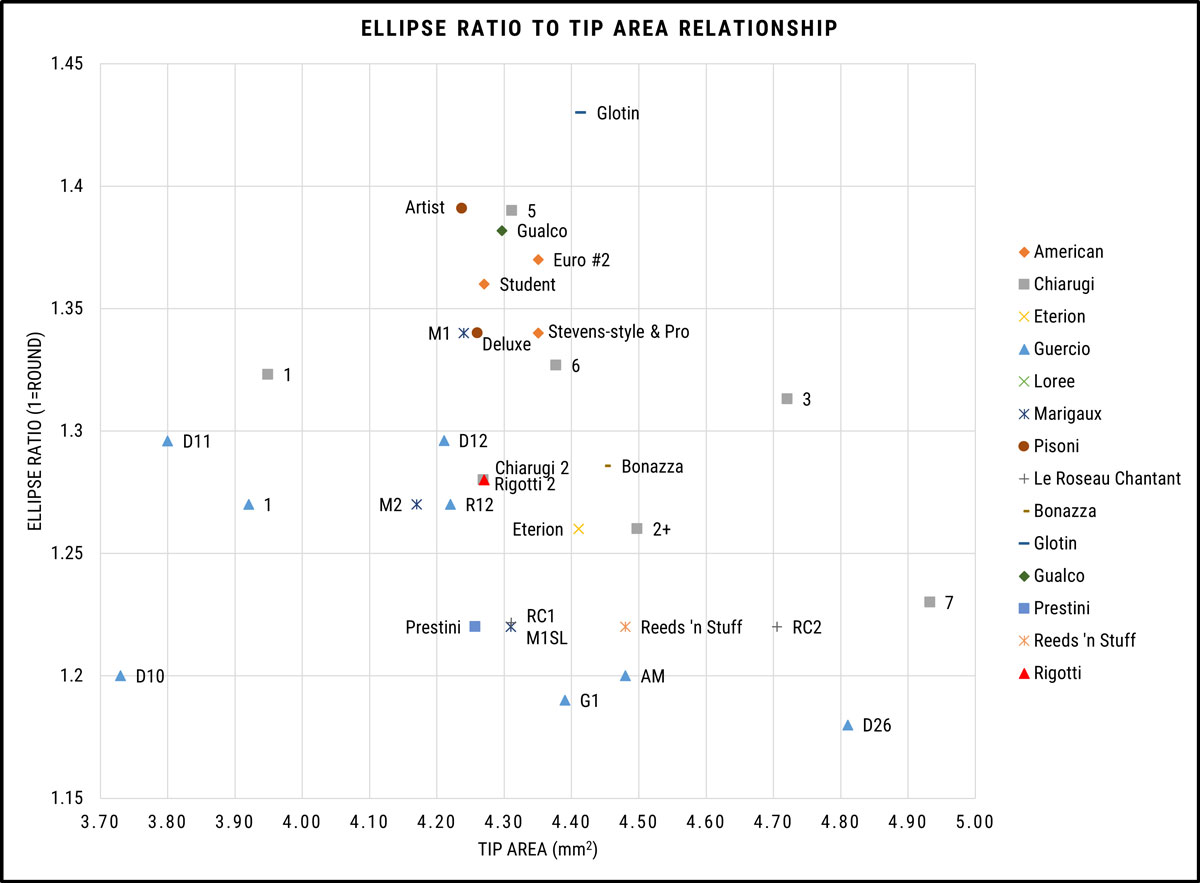
4. Average Taper (Tip-to-Base Ratios)
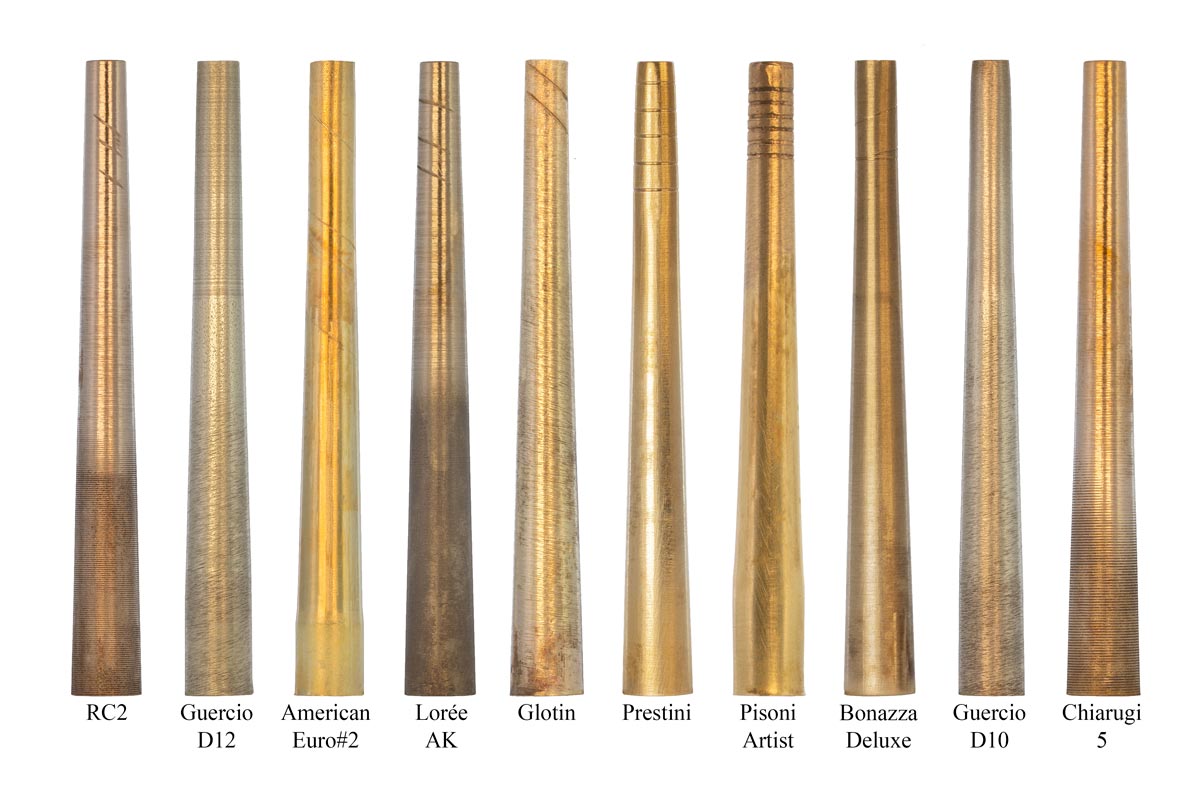
Staple taper styles affect the aperture and volume of the reed and, to a small degree, the back pressure.
Most staples fall into a traditional taper angle range as can be seen in the line graph below. However, there are some outliers that were created to address specific pitch idiosyncrasies with certain oboes.
Also, although most back pressure is caused by a small tip area and relieved somewhat by increasing the tip area, a straighter overall taper angle can also reduce back pressure to a small degree.
Tip-to-Base Ratios
The tip-to-base ratio tells us how different the staple tip area is to the base area. Looking at tip-to-base ratios can give you an idea of whether you’re reducing the tip or enlarging the base in relation to each other and then the Pitch of the Octaves discussion above can be applied.
For example, if I were using a Chiarugi 2 staple with my Joshua+2 shaper tip and I was having trouble with the middle register getting progressively flatter from A 5 - C6, I could try to counter that issue by increasing the staple tip size in relation to the base. If you study the tables with base measurements and tip area measurements, you will find that the American Stevens-style staple has a similar base measurement to the Chiarugi 2, but the tip area is bigger. If you examine the Tip-to-Base Ratio Table, you find that the Chiarugi 2 is toward the larger-angled end of normal, while the American Steven-style is in the straighter side of normal. This may be a subtle enough change to fix the problem without causing too many other issues.
Average Taper Graph
The following graph shows the relationship between the base area and the tip area and gives a quick visual of less tapered staples vs. more tapered staples. The staple models closest to the line and toward the middle of the graph are the ones that are the most standard. Those close to the line toward the bottom left corner are small all the way around, and those close to the line at the top right corner of the graph are big overall. Those furthest away from and above the line have the strongest average taper angles. Those furthest away from and below the line are the straightest.

Taper Angles
Wait. Isn’t the taper angle the same as the tip-to-base ratio?
No. The tip-to-base ratio is based on average areas of the tip and base. Staples are not round at the top, so the angles are different depending on whether you’re looking at the front/back of the staple or at the sides. Additionally, many staples don’t just have one angle from top to bottom even if you’re only looking at the sides. Many staples start from the bottom at one angle and then change part way up to a different angle. Some even have short changes in the middle, that could be called a shoulder, and some have a steeper angle at the tip.
Different brands of staples have slightly differing angles and angle changes. Where and when the angles of the taper change affects the internal volume of the staple.
For example, we can compare the Guercio AM to the Lorée AK. They have essentially the same base diameter and tip area, but the Guercio AM has a significantly higher volume within the staple because the taper angle is straighter and then flares inward near the tip, while the Lorée AK is more evenly tapered and therefore narrower throughout the body. For an illustration of this example, see the following section.
Average Taper Chart
The tip-to-base ratio is determined from the tip area and base area but doesn’t consider any inside angle changes, so this is not going to tell you much about volume, although it will tell you about tip and base relationships. The smaller the number, the less angled the average taper is from top to bottom, and the straighter the shape. The larger the number, the more angled the average taper is, and the more conical the shape.
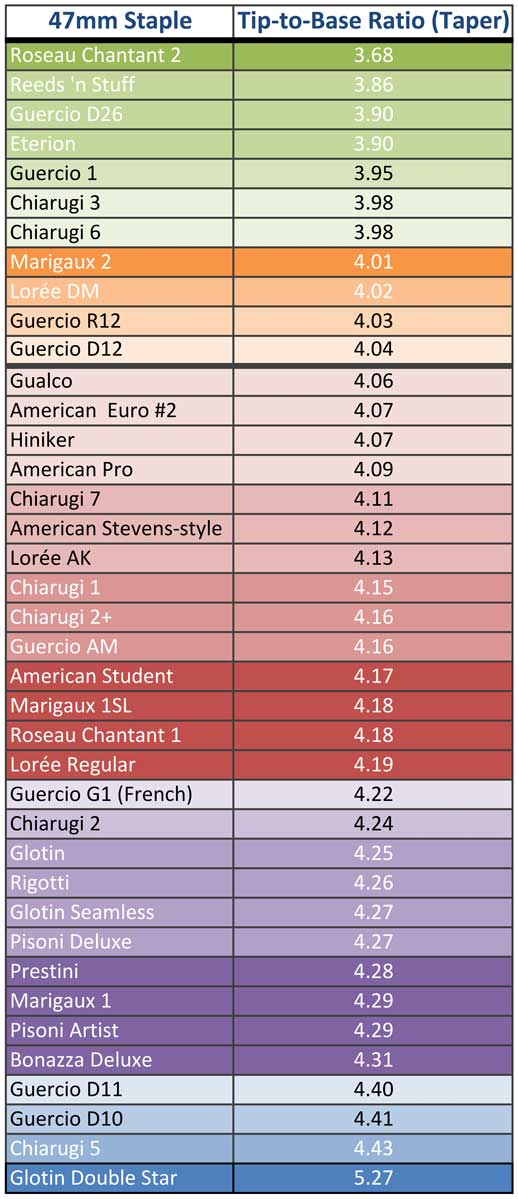
5. Volume (Internal)
I’ve mentioned volume several times already, so let’s talk more about it now.
The larger the staple, the greater the volume within the reed, but with a complimentary cane shape and proper overlap you can bring the reed tip aperture down to a workable size.
Guercio offers staples with a large volume inside the staple due to different taper angles, and, on some staples, they also angle the staple tip inward at the last millimeter to reduce the staple tip opening, making the top to bottom ratio more standard while still having more internal volume.
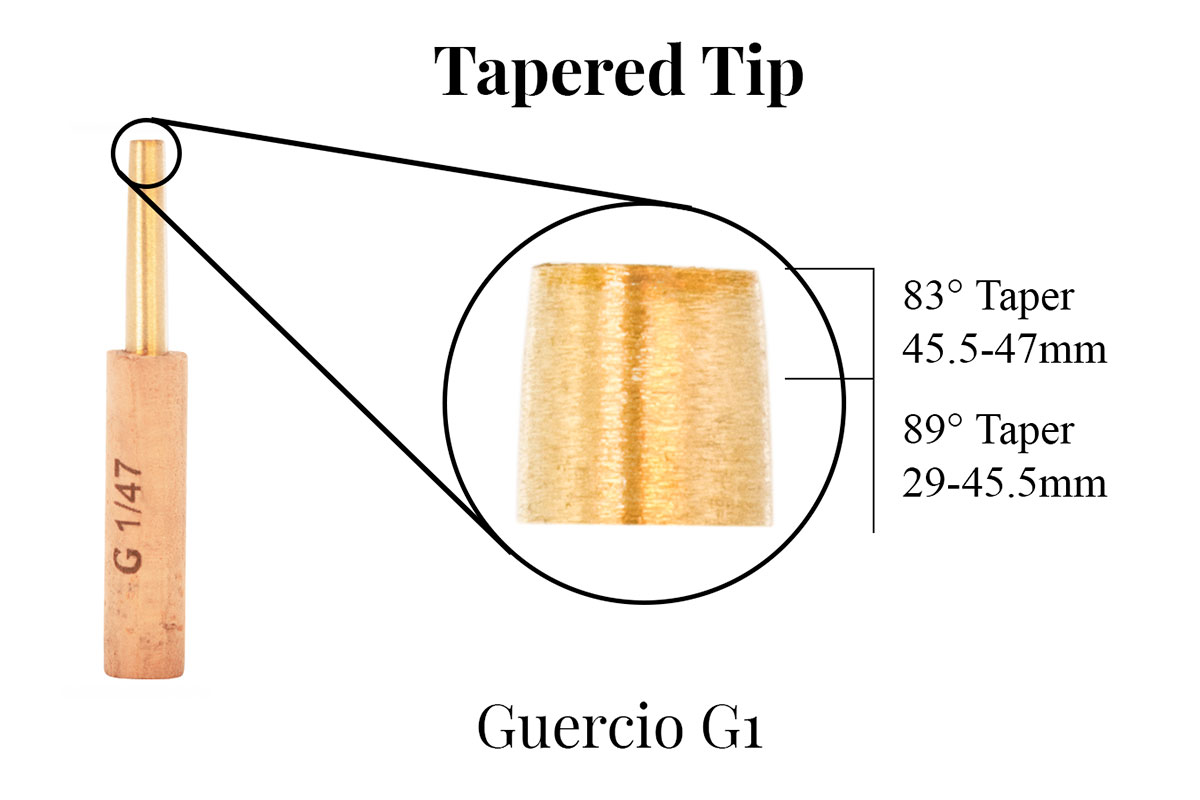
As was described in the previous section, we can see the difference in the volume of the Lorée AK and the Guercio AM staples just by comparing the taper angles in the picture below. (The angle measurements are the actual angles of a standing staple. We are not labeling a degree of angle change.)
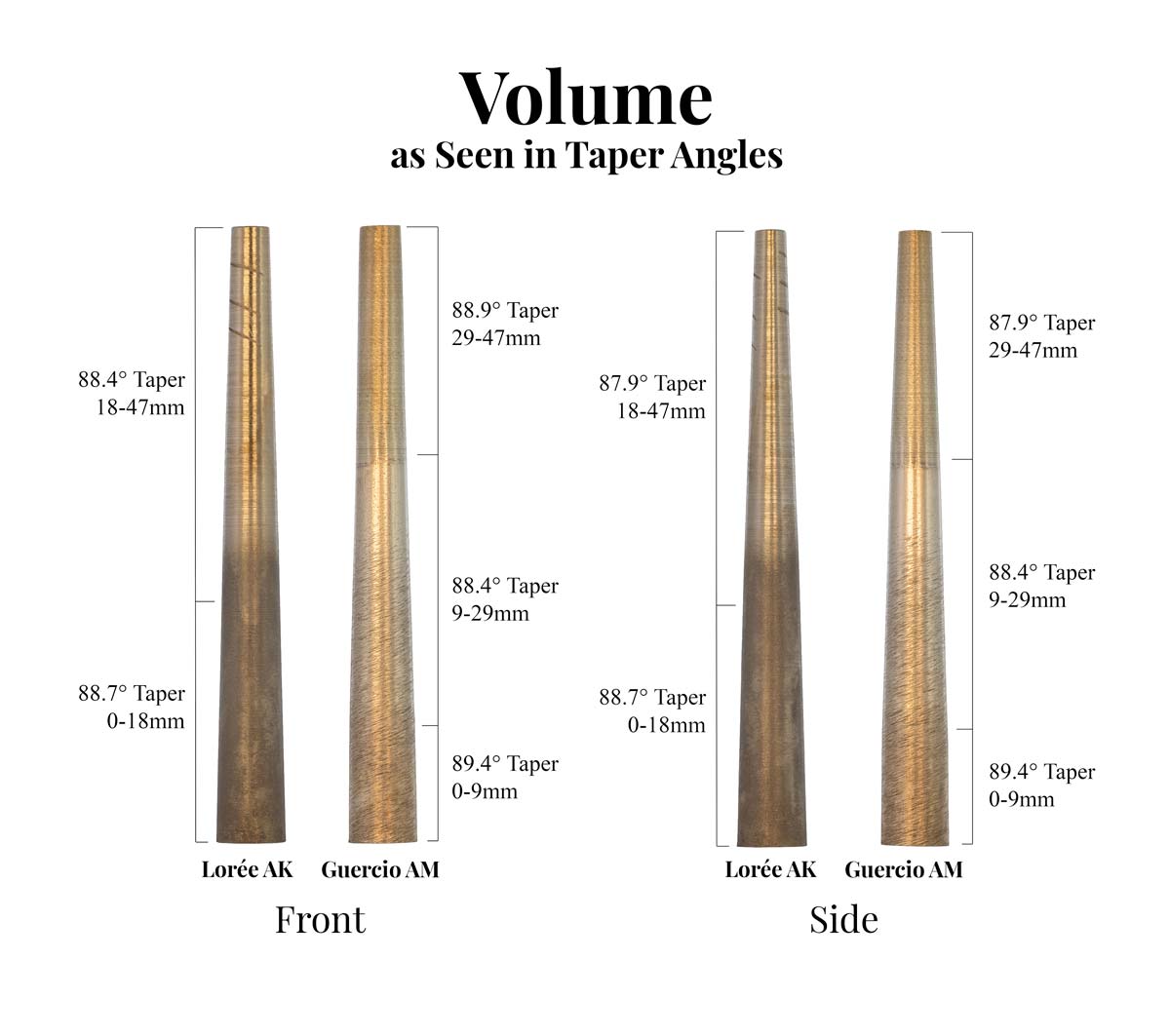
While it is true that the larger the volume, the higher the back pressure, it is a very slight difference and may not be noticeable. Proportionally, the tip size affects back pressure 50 times more than volume.
Additional effects of internal volume have not been well studied, but some players experience greater dynamic range and freer response with higher volume staples.
Volume Chart
Volume was determined using water and a tiny digital scientific scale accurate to 1 milligram. Ten staples of each model were filled with water and then the water was weighed. An average was taken for each model.
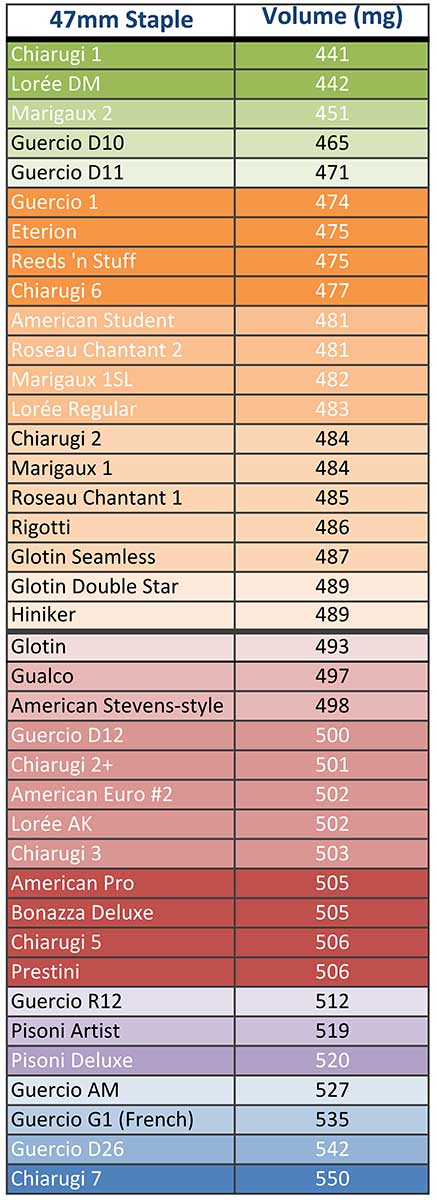
6. External Dimensions (How the Cane Fits)
How do the external dimensions affect anything? There’s no air flowing on the outside.
As has been mentioned in a few other places, the larger the staple tip, the shorter the cane needs to be tied on the staple to seal properly.
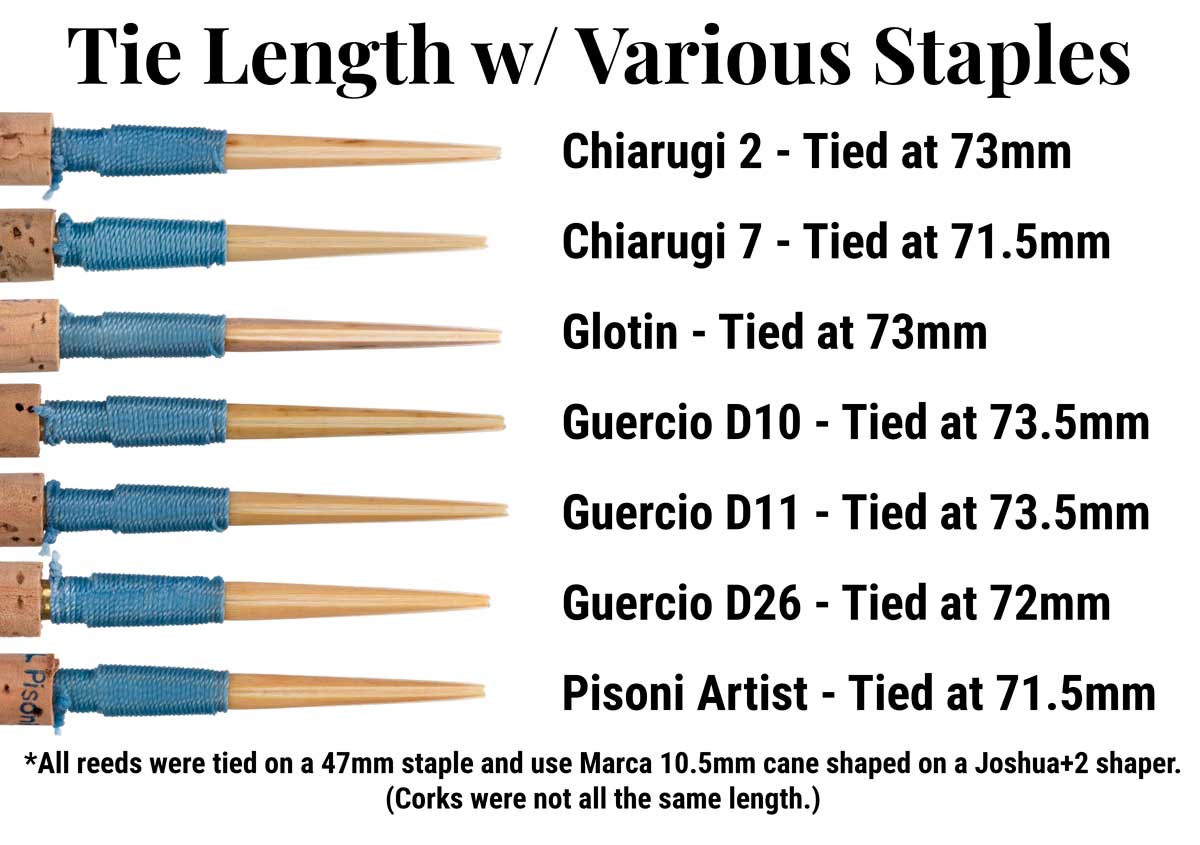
The greater the width at the tie-on point, the greater the volume of the reed, especially in the back of the reed near the string. Slackening off the tension of the thread on the last wind or two at the top of the staple can reduce the reed tip aperture a bit, helping keep the pitch up.
It is helpful to choose your cane diameter to enhance the qualities of the staple. Staples that encourage a bigger reed tip aperture can be compensated for by a larger cane diameter, and for staples that create a smaller reed tip aperture, a smaller diameter cane can compensate.
Outside Tip Area Chart
This chart can give you an idea of whether the staple you are using is considered to have a large or small external dimension, to determine if you should be adjusting your cane diameter or tie-on length for accurate results.
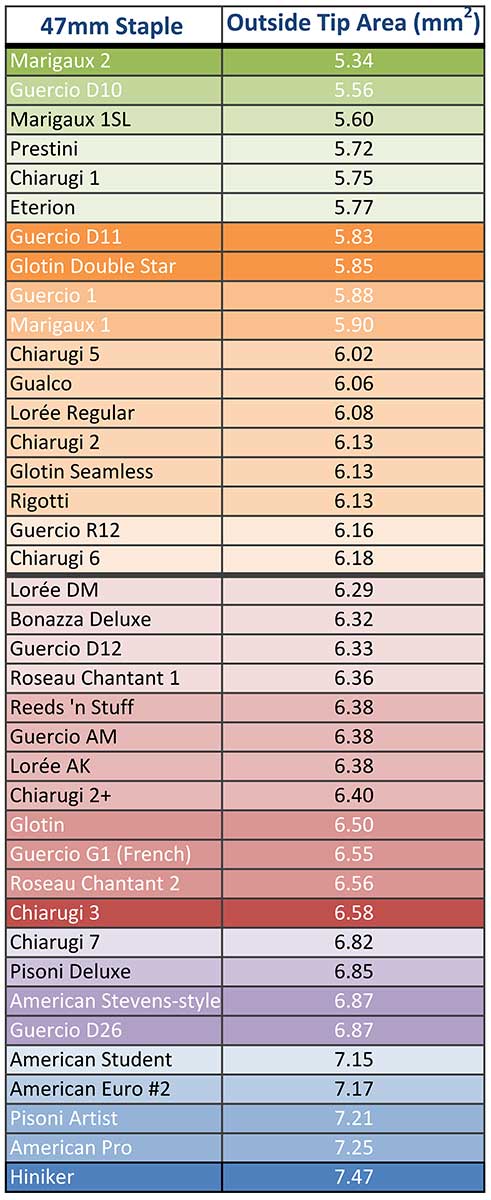
Staple tip area is not the only thing that affects how you tie your cane on. Thickness of the metal wall adds to the overall size that the cane needs to conform to.
7. Wall Thickness
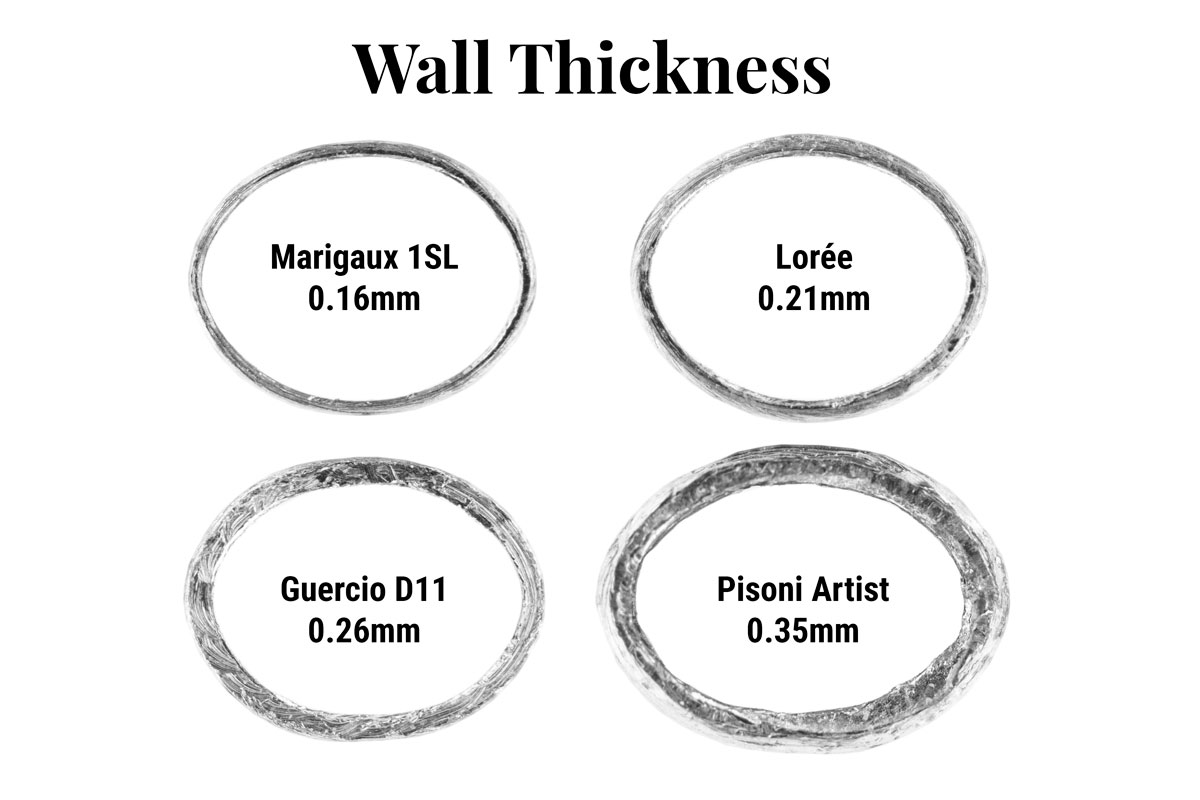
Tie-on Length
Wall thickness significantly affects the outer dimension of the staple tip compared to the internal tip area. Staples with a similar internal tip area but significantly different wall thicknesses will need the cane to be tied on at different lengths to get the proper seal.
For example, the Chiarugi 2 and the American Student staples have the same tip area, but the American Student staple has a wall thickness that is 0.11 millimeters greater than the Chiarugi 2. The perimeter of the Chiarugi 2 is 8.85mm and the perimeter of the American Student is 9.58mm. That means you need .375mm (or ⅜ of a millimeter) more width in your cane for the American Student than for the Chiarugi 2, which may mean tying the cane 1 - 1.5mm lower on the American Student staple than the Chiarugi 2, depending on your shape.
Tone and Resistance
Wall thickness also affects the tone and resistance of the reed. The thicker the staple walls, the more resistant the reed which may make a nice pairing with a less resistant oboe or reed scrape. Thicker walls also give a darker, fuller tone, which is usually desirable. The Pisoni and American staples have the thickest walls.
Thin-walled staples vibrate more quickly, distinctly reducing the amount of effort required to play. The Eterion, Marigaux 1SL, 2, and Prestini are the thinnest-walled staples.
They also require the cane to be tied on a little longer.
Taking the same comparison staple above, the Chiarugi 2 at an 8.85mm perimeter, and comparing the perimeter to the thin-walled Marigaux 1SL at 8.44mm, which is closest in tip area to the Chiarugi 2, the difference is 0.41mm, meaning you would need to tie your cane on ½ to 1 millimeter longer for the Marigaux 1SL.
Cooper Wright, Principal Oboist of the Bandung Philharmonic (Indonesia), loves thin-walled staples, writing on a website oboe Bboard,
There’s something more liquidy, almost chocolaty that comes out of a thin-walled staple that can’t be reproduced on a thicker-walled staple.
Interestingly, the wall thickness of staples is not necessarily consistent from top to bottom. It is not clear to us whether these are purposely calculated or just a natural result of the manufacturing method. It is also not apparent what effect these differences may have on how the staple functions, especially since the bottom 2/3rds of the vibrations are dampened by the cork anyway.
In general, staples manufactured with the rolling method seem to have thinner base walls than tip walls, while those made on a CNC machine are often designed with thicker base walls than tip walls, or in some cases have the same thickness. In most cases, there is a consistency between brands.
Thicker at the Bottom
- Chiarugi
- Lorée
- Marigaux
- Rigotti
and to some degree
- Glotin
- Prestini
- Roseau Chantant
Same Thickness
- Bonazza
Thinner at the Bottom
- Guercio
and to a greater degree
- American
- Pisoni
Staple Tip Wall Thickness Chart
For the following chart, staple tip wall thickness was measured on both long sides of the tip ellipse and then averaged for each staple and then 50 staples were measured for each brand model and averaged to give the measurements in the chart.
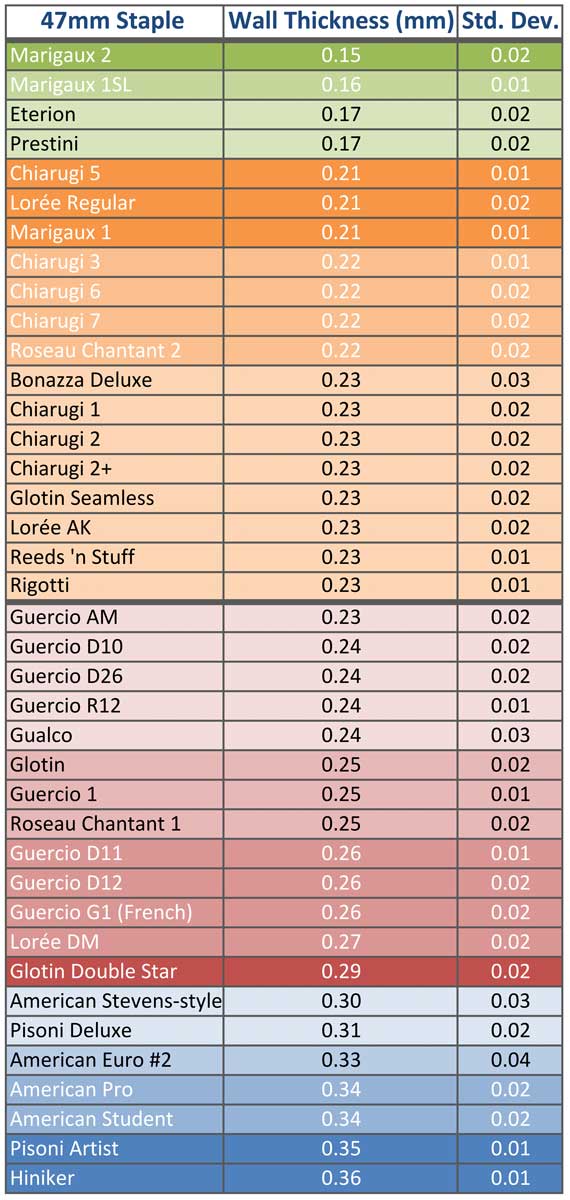
8. Length
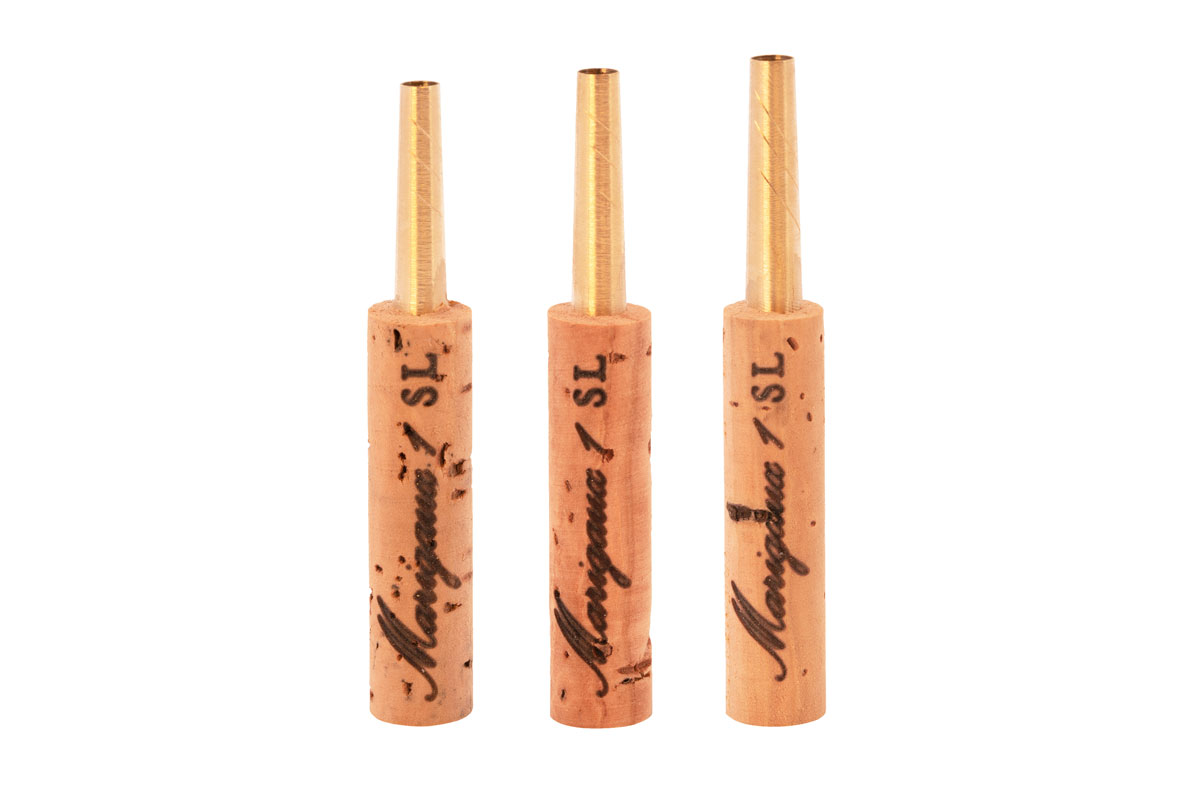
Pitch, as has already been discussed, is the most obvious result of length differences in staples. One millimeter makes a difference of 5 - 6 cents at the A4. There are 4+ cents in 1 Hz so if you typically play A4 at 440 Hz on a 47mm staple and change to a 46mm staple, it will raise your pitch to about 441.5 Hz. See pp. 451 - 455 (Chap. 16D) in Understanding the Oboe Reed for a detailed discussion on all the effects.
Staple length is also well paired to the staple bore and coordinated to the cane shape. A 47mm staple works well with the narrow cane shape and long scrape that is most commonly used in America as well as for the standard orchestra pitch of 440 Hz. A negative effect of shortening the staple is that the region above A5 is weakened and flattens. Choosing a staple with a larger tip can offset this tendency.
Americans typically prefer a 47mm staple, though 46mm is becoming more common than it used to be. Well-known American oboists interviewed in Graham Salter’s book Understanding the Oboe Reed who use or sometimes use 46mm staples include Elaine Douvas, and Liang Wang in New York. Eugene Izotov sometimes uses 46.5mm while Richard Woodhams and Dwight Parry also recommend a 46.5mm staple. They usually hand file the base of a 47mm down a ½ mm. We offer the American Euro#2 and Stevens-style staples at 46.5mm.
45mm - 48mm
The Canadian company, Le Roseau Chantant, has tested several staples to see which lengths work the best in terms of balance and tonal qualities for a given staple model both for European and American reeds. Europeans generally use 46mm, though some use 45mm. For example, Christoph Hartmann and Jonathan Kelly of the Berlin Philharmonic use 45mm Glotin staples for a 70+mm reed playing at 443 Hz. Their wider reed shape and shorter scrape help to keep the octaves in tune.
Chiarugi 2+ – According to Le Roseau Chantant, this is more stable in the 46mm and 45mm versions. There was instability on the G5 and C6 at the 47mm length. (Omar Zaboli, working in Switzerland, plays on a 45mm Chiarugi 2+.)
Chiarugi 3 – Le Roseau Chantant finds that the European scrape works especially well at the 46mm and 45mm lengths, and the American scrape works best at 47mm.
RC1 – designed by Le Roseau Chantant but very similar dimensions to the Chiarugi 2 staple. These both work well in any length on French oboes and with Mönnig. Although Le Roseau Chantant determined that only the 47mm length of the RC1 works with Ludwig Frank and Josef instruments, other players of these instruments would disagree.
48 mm staples are rarely used, especially in the orchestra. Not a single player whose reeds are displayed in Understanding the Oboe Reed had made a reed on a 48mm staple. The only use that we have found is for the oboist who needs to play with a stereotypically flat organ. We carry the Chiarugi #2 adjustable staples that can serve that purpose. Changing your pitch in this way will not have uniform results between the octaves; however, it may be the easiest way to manage the situation.
9. Metal Type
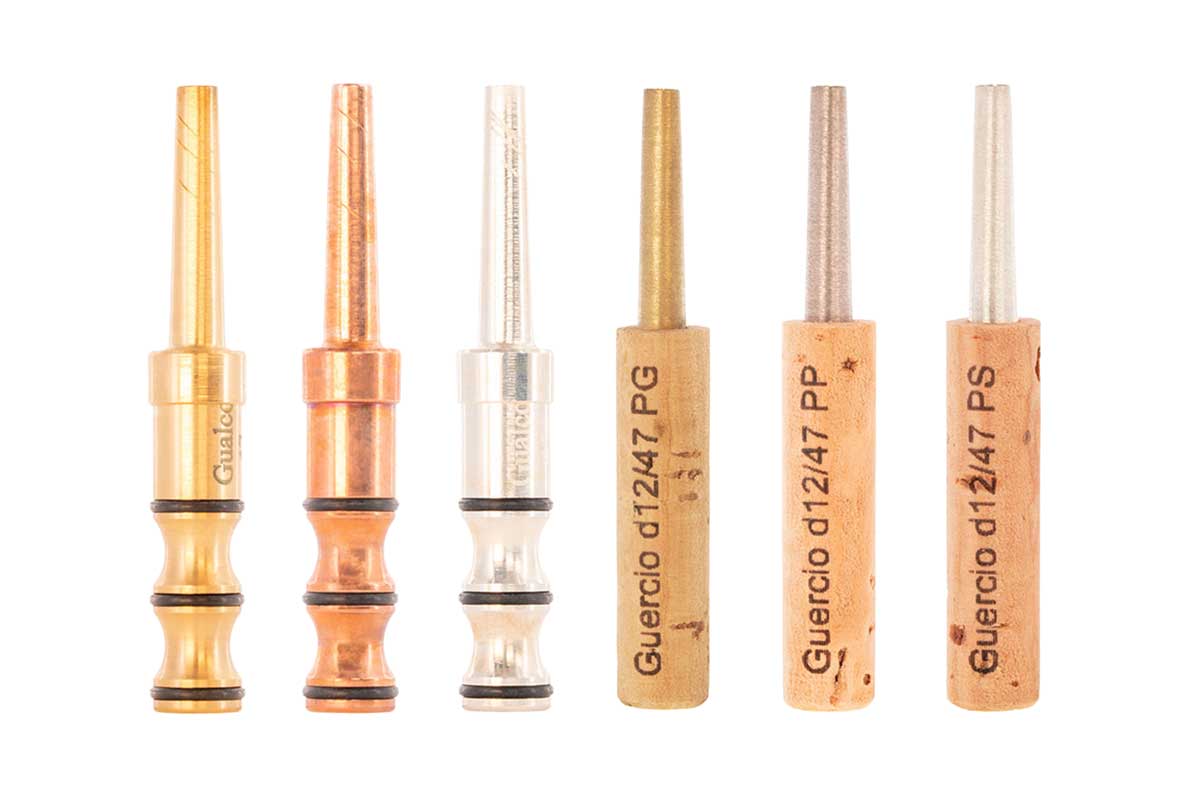
There are now numerous metals and alloys available to try to find the perfect tone quality. Let’s look at each one individually.
Density, Hardness, and Speed of Sound in Metals and Alloys
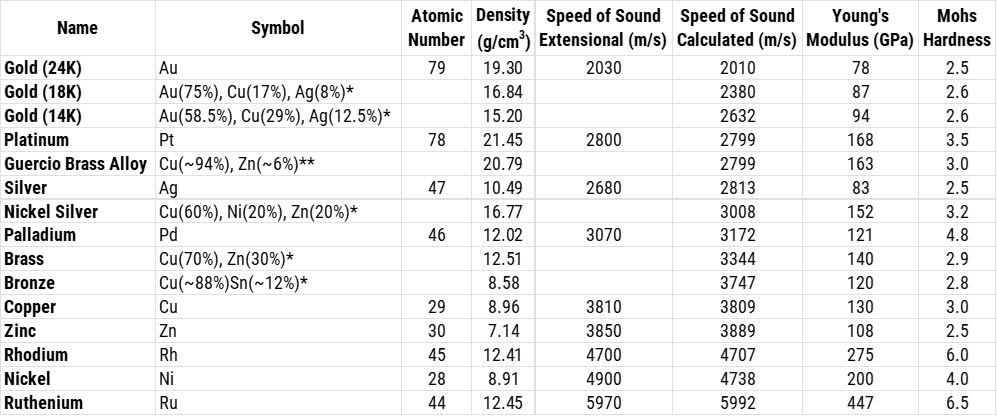
*Alloy compositions can vary depending on the manufacturer.
**The Guercio Brass Alloy is our best guess of its composition based on notes by the manufacturer and are not guaranteed to be correct.
We have not drawn any definitive conclusions based on these characteristics. You can decide, based on your own experience, how these properties may affect the tone.
The extensional speed of sound is the velocity of the longitudinal wave in a thin rod. Values were sourced from Wikipedia.
The speed of sound in a solid depends on the Young's modulus of the medium and the density
Speed of Sound = √Young's Modulus/Density (± 5%)
Young's modulus is a measure of the ability of a material to withstand changes in length when under lengthwise tension or compression. Young's modulus is equal to the longitudinal stress divided by the strain. - Encyclopedia Britannica
The wavelength of the soundwave and the temperature of the medium are additional variables that can change the speed of sound.
Brass
Brass is the standard staple material and there are some differing alloys based on which brand you try. Brass is typically an alloy of 70% copper and 30% zinc. Generally, brass gives a sweeter tone than nickel-silver. In addition to the normal alloy, Guercio also offers on just their D11 and D12 staples a special alloy that is advertised as having 35% more copper, which theoretically would make it 94% copper and just 6% zinc. This special alloy is considered by some to have a gentler sound, a soft and warm tone with more resonance. The Chiarugi alloy which is assumed to be the standard brass alloy is more vibrant.
Nickel-Silver
Nickel-Silver, also known as German silver, is a formulation of copper (60%), nickel (20%), and zinc (20%). Nickel-silver is considered by many to be bright, with excellent projection, and a brilliant sound. However, others feel it to be harsh or relentless, although some like that as it compliments their scrape. (Salter p. 422)
Bronze
Bronze is a copper and tin alloy. Though there are different alloys in bronze, the most likely alloy is about 88% copper and 12% tin. Bronze has a rich and dark timbre somewhere between the brass and copper-plate experiences. Because of its high level of copper, it is most similar to the Guercio Special Brass Alloy which also has a high level of copper. Mark Chudnow offers some of his staples in bronze.
Silver-Plate
Silver-plate is very similar in tonal quality to the Guercio special brass alloy, which is characterized as offering a gentler sound than typical brass or nickel-silver. However, there is still a bit more strength in it than gold-plate. Bonazza Deluxe staples and Gualco staples have a silver-plated version.
Solid Silver
Solid silver is darker in tone than nickel-silver and slightly more responsive. Guercio offers their D12 in solid silver.
Copper-Plate
Brass is sometimes plated with other metals to get more options in tonal subtleties. Copper presents a gentler tone, especially in the low register. It is also described by the oboe-blog.de as “warm, dark, pleasant, and soft, with very nice and reserved low notes.” They also point out slightly more resistance than standard brass, but it is not enough to be annoying. Gualco staples have a copper-plated version.
Gold-Plate (18K gold alloy)
According to the Rhodium-Aurum website that specializes in plating staples with different precious metals, gold-plated staples have comfortable lower notes and an enriched warm sound. The oboe-blog.de characterizes it as having 'easier vibration and a warm sound'. Guercio offers their D12 in gold-plate.
Solid Gold (18K and 14K gold alloy)
Probably the warmest, mellowest sounding staple, solid gold staples provide a unique sound and feeling, with all the characteristics of the gold-plated staple taken to an extreme. Guercio offers their D11 and D12 models in 14K gold and 18K gold. Due to the high price point ($225 for 14K, and $240 for 18K), we do not regularly stock these staples. If you are interested in purchasing these, please contact us and we will place a special order.
Palladium-Plate
Guercio offers a palladium-plated staple. These are a silver color, and based on their properties should be similar to nickel-silver, with slightly more focus.
Rhodium and Ruthenium-Plate
We don’t carry these metals in staples, but the company Rhodium-Aurum makes these, and they are both louder, more direct, robust, and focused than the others mentioned above, with the Ruthenium-plated option being the more so.
Superstaples – available under the Chiarugi and Chudnow brands
Superstaples are the staples made without cork, and can be found in several styles: what has become known as the ‘S’ Staple (Solid base) and the ‘E’ Staple (Excavated base), and also the ‘M’ Staple (Midway Solid) which shows a solid base only half as long.
These staples use metal to replace the sound-deadening cork, and are claimed to have a more even tone throughout the entire range. The extra metal on the solid base staple causes extra resistance but significantly extra projection.
Critics describe a sound that is rather trumpet-like or too bright.
Several changes have been introduced to address these concerns. In the ‘E’ staple, the extra metal is mostly removed or “excavated” out between the O-rings. This vibrates significantly more responsively. The ‘M’ Staple just removes the top half of the thick part and adds an O-ring in the middle for stability.
Ebony Core (Gualco)
Gualco oboe staples are similar to the excavated Superstaples. They are unique, though, because they have an ebony insert inside the bore of the middle section of the staple. The wood is meant to help with the vibrations in the large amount of metal that must vibrate and softens the tone to be more oboe-like.
They are available in solid brass, copper-plated brass, and silver-plated brass.
- Brass has the gentlest tone.
- Copper is also gentle, especially in the low register.
- Silver plate on brass gives a lighter sound.
10. Quality and Consistency
How do the brands measure up in quality and consistency? We’ll first answer this question by describing the different manufacturing methods.
Manufacturing Methods
Different manufacturing methods lend themselves to the varying levels of consistency.
Hammer-Forged
The old school method is hammer-forging, using equipment that dates back to the turn of the 20th century. The cylindrical section at the bottom of our American staples and the Pisoni staples is made that way because of this process.
Rolling Procedure
The Guercio company manufactures their staples by hand without turning on a lathe, making extruded seamless tubes with a non-cutting, proprietary rolling procedure according to the Klopfer principle.
Glotin rolls their seamed staples from a flat sheet of metal around a proprietary shape, closed with a silver-brazed seam. Glotin is the only one these days to still make seamed staples.

CNC Lathe
Chiarugi machines their staples on a CNC lathe, making very consistent staples on one taper angle for the entire length of the sides, and changing angles once or twice on the front and back. The staples are drawn from a full bar of brass or nickel silver, and then they are completely turned outside and inside using high precision machines and automated systems. This produces high quality, consistent tubes.
I’m sure you can imagine which method will be more consistent. Let’s look at what we know about each of the brands.
- Because Chiarugi makes their staples using CNC machines, they are naturally the most consistent and of a high quality. Eterion, Lorée, Marigaux, Reeds 'n Stuff, Rigotti, and Le Roseau Chantant, (and Chudnow) are made by Chiarugi and are therefore very consistent. Prestini also uses a CNC machine, but they are still less consistent than Chiarugi.
- Guercio's finishing is of high quality, but the tip shape is not super consistent, particularly with the staples that are more round in the tip.
- Pisoni and American staples are made differently using a hand-craft method that makes it more difficult to achieve a high level of consistency.
- Glotin's method of rolling from a flat piece of metal, creating a seam, is the least consistent.
The area where consistency is most difficult to achieve is in the staple tip shape (ellipse ratio). This list shows the standard deviation amounts for each brand in increasing measure.
- Chiarugi-made staples - .01-.02 mm
- Bonazza - .02 mm
- Gualco - .02 mm
- Pisoni - .02-.03 mm
- Guercio - .02-.06 mm depending on the staple style
- American brand - .03-.05 mm
- Prestini - .05 mm
- Glotin - .06 mm
The standard deviation range for the base is not quite as high among all the staples as is the tip shape. However, Glotin still comes out the worst at a standard deviation of 0.07mm. The level of quality in Glotin staples of more recent times has been a noted concern by many, though oboists like John Ferrillo, who loves the Glotin staple, takes extra time to seek out the best shaped staples for his reeds and for his shop.
The next chapter covers each individual staple brand and model that we carry in our store. You'll find technical information about each staple
Works Cited
Benade, Arthur & Richards, W. Bruce. Oboe normal mode adjustment via reed and staple proportioning. The Journal of the Acoustical Society of America 73, 1794 (1983).
Draving, Wolfgang. Air Flow Analysis of Oboe Reed Staples. IDRS Vol. 42 No. 2, 2019
Howarth. "Oboe Tubes (Staples)."Howarth London. https://www.howarthlondon.com/accessories.aspx?cat=42&accinst=5. Accessed 17 December 2021.
Marigaux. "Oboe Staples."Marigaux. https://accessories.marigaux.com/en/reed-making-tools/staples/. Accessed 18 December 2021.
Nederveen, Cornelis J. Acoustical Aspects of Woodwind Instruments. Northern Illinois University Press, 1998.
The Oboe Shop @ Crowthers. "Chiarugi 47mm 2+ Brass Staple. "Oboe Shop. https://oboeshop.co.uk/chiarugi-47mm-2-brass-staple/. Accessed 17 December 2021.
Oboe Shop GmbH. "Oboe Staple Guercio 1."oboe-shop.de. https://www.oboe-shop.de/en/oboe-staple-guercio-1.html. Accessed 18 December 2021
Le Roseau Chantant. "Oboe Staples." Le Roseau Oboe. le-roseau-oboe.com/en/product-category/accessories-oboe-cor-anglais/staples/oboe-staples/. Accessed 17 December 2021.
Salter, Graham. Understanding the Oboe Reed. 2nd Edition, published by Graham Salter, 2021.
